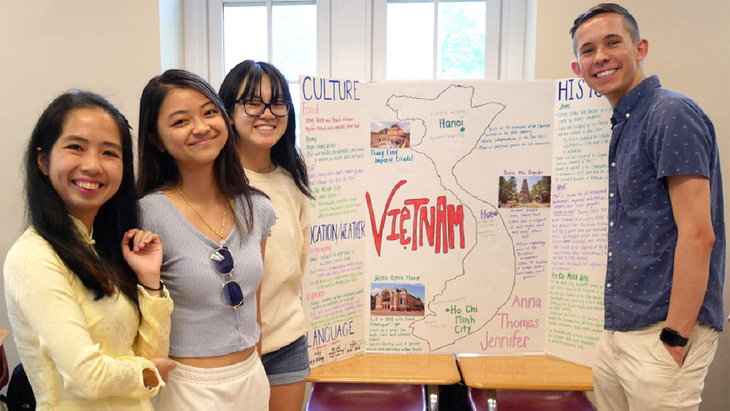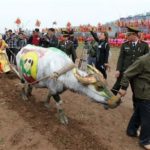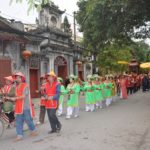In July 2021, when the COVID-19 pandemic was still ongoing and complicated, a Vietnamese girl made her way to the United States to teach her mother tongue at the University of North Carolina at Chapel Hill (UNC). She was determined to make a difference and help bridge the language barrier, despite the looming threat of the virus.
After a 15-year hiatus, the university recently launched its first Vietnamese teaching course.
The girl, named Ton Nu Tuong Vy, has journeyed to 36 countries and territories around the world to gain insight into the education, culture, and daily life of local inhabitants.
Vietnam is a wonderful country with so many great reasons to love it. From its stunning landscapes and captivating culture, to its delicious food and friendly people, there truly is something for everyone to appreciate about this vibrant and unique nation. Here are just a few of the many reasons why so many people have come to love Vietnam:
Beautiful Landscapes
Vietnam boasts some of the most beautiful and varied landscapes in the world. From the majestic mountains of the North to the picturesque beaches of the South, Vietnam’s scenery is truly breathtaking. From the terraced rice fields of the Mekong Delta and the karst hills of Halong Bay, to the lush forests and stunning coastal views, Vietnam is a visual treat for all who visit.
Vibrant Culture
Vietnam is home to a vibrant and fascinating culture that is deeply rooted in traditions and customs. From the colorful festivals and traditional markets, to the amazing handicrafts and museums, there is so much to explore and learn about the culture of Vietnam. Whether you’re interested in learning about the country’s history, or just want to experience its unique customs, you’re sure to find something to love about the culture of this amazing nation.
Delicious Cuisine
Vietnam is also known for its delicious cuisine. From the flavorful pho and bánh mì to the aromatic lemongrass and chili, there’s something for everyone to enjoy. Whether you’re looking for a light snack or a full-flavored meal, the food of Vietnam is sure to delight your taste buds. And with a wide variety of street food vendors and restaurants, it’s easy to find something to satisfy your cravings.
Friendly People
The people of Vietnam are known for their warm hospitality and friendliness. From the locals you meet in the street to the staff at the hotels and restaurants, you’re sure to find people who are happy to help and eager to make your stay in Vietnam as enjoyable as possible. Whether you need help navigating the city or just want someone to chat with, the people of Vietnam are always welcoming and willing to lend a hand.
These are just a few of the many reasons why so many people have come to love Vietnam. From its incredible landscapes and vibrant culture, to its delicious food and friendly people, it’s easy to see why Vietnam has become such a beloved destination. So why not experience it for yourself and see what all the fuss is about?
The Vietnamese language course at the University of North Carolina (UNC) was organized within the framework of the prestigious Fulbright Foreign Language Teaching Assistant (FLTA) program, which lasts for a period of nine months. This program provides a great opportunity for students to gain an in-depth understanding of the Vietnamese language, culture, and customs. Participants of the program benefit from instructional materials developed by professional language instructors, as well as the support of native Vietnamese-speaking mentors. With this program, students can further their linguistic knowledge and gain valuable insight into the Vietnamese culture.
As it was an optional subject, students put forth great effort into their studies. In Vy’s class, there were mainly Vietnamese Americans, as well as two native students with various motivations to learn Vietnamese.
One of them had a Vietnamese friend and wanted to gain a deeper understanding of their culture and language. They wanted to build a strong bond and be able to communicate more effectively.
Another student’s grandmother was Vietnamese, but she couldn’t understand what her grandmother said. Out of love for her late grandmother, she decided to learn Vietnamese in order to stay connected to her roots.
Although she is an extraordinary student [in my class] who has not had the chance to communicate or write in Vietnamese in her home like other students, Vy noted that she strives harder to learn the language than anyone else.
Vy remembered that, fifteen years ago, an American teacher went on a journey to Vietnam and, as a result, opened a class to teach the Vietnamese language to those in the United States who wanted to gain a better understanding of the Southeast Asian country.
After the professor retired, no one took over his class and the Vietnamese course was put on hold. Unfortunately, the students had to wait until a new professor was found to take up the post.
Until 2021, when the demand for learning Vietnamese among UNC students surged, the university reinstated its Vietnamese class. In early August, Vy arrived in the United States and secured a job.
Vy was tasked with teaching a special curriculum, which required her to search for books and documents to inform her lesson plans. To ensure she had the required material, Vy scoured libraries, bookstores, and online resources to locate the necessary texts and resources. In addition, she reached out to knowledgeable colleagues to gain insight into the best materials for her students. With a thorough understanding of the subject matter and a comprehensive collection of resources, Vy was able to create lesson plans that were engaging and informative.
She scoured bookstores, scoured the internet, and interrogated her associates to compile and pick out the pertinent materials for her lessons.
Vy also organized a variety of extracurricular activities, such as letting her students watch and discuss movies, such as Mat Biec (Dreamy Eyes) and Da Co Hoai Lang (Missing Husband at Nightfall). She also held activities centered around important holidays, like Tet and Valentine’s Day.
In addition, Vy invited students from Fulbright University Vietnam to share Vietnam’s rich and vibrant folklore online. This provided a great opportunity for the students to connect with each other and spread knowledge about their culture to a greater audience.
During these activities, Vy’s students in the U.S. asked many inquisitive questions. For example, after watching Mat Biec, they wanted to know more about the Hue University of Education. They were also curious to learn why Vy’s ao dai (a traditional Vietnamese outfit) was colorful, whereas schoolgirls in Thua Thien Hue Province, central Vietnam, were only allowed to wear white ao dai to school.
This was an exchange and pronunciation practice opportunity for students.
Vy was always eager to provide private tutoring to students who had difficulty keeping up with their peers. A regular class typically lasts 50 minutes, while private sessions last for two hours.
I eagerly volunteer to help and hope my Vietnamese knowledge and understanding, as well as pedagogical approaches, enhance to benefit my students,” Vy shared.
Productive Outcomes
Fruitful results can be achieved when one puts in the necessary effort. With dedication and hard work, it is possible to produce productive outcomes.
In a final-term project that was designed to encourage creativity, Vy expressed her surprise and admiration for the ideas and stories her students had come up with.
A student who was born into a Vietnamese, Chinese, and Khmer family and had a great passion for languages made a representation on comparing the three languages.
The student was particularly interested in the similarities and differences between these three languages, which are all part of the larger Southeast Asian language family. Through careful study and analysis, the student determined that Vietnamese and Khmer have many similarities, such as their shared use of tones, while Chinese is more distinct from the other two languages.
The student also found that the writing systems of each language were different. Vietnamese is written using a Latin alphabet, while Chinese employs a logographic system, and Khmer uses a syllabic system. Despite these differences, the student found that the three languages share many similar grammar and syntax rules.
The student’s representation of the similarities and differences between these three languages provided a unique and interesting insight into this particular language family. It is a great example of how one person’s passion for language can lead to fascinating discoveries.
Another student shared their mother’s pho (Vietnam’s national noodle dish served with hot broth cooked from beef or chicken) recipe by drawing out the materials needed, including star anise, cardamom, and beef.
A student recently created an impressive piece of artwork, combining a painting and a video to tell the story of her family history. The painting and video offer a vivid look into the past, allowing viewers to connect with her family’s legacy in a meaningful way. The artwork is a testament to the importance of preserving our ancestral stories and passing them down to future generations.
After completing the course, the students’ reading and writing abilities had greatly improved.
Vy was delighted by her students’ connection with their families and Vietnamese culture. Some even declared that they would visit Vietnam with their families in the future.
In her nine months working at the University of North Carolina (UNC), Vy received considerable support from her colleagues and students. They knew that it was her first year teaching at the university and understood the challenges that come with adapting to life in the U.S. This compassionate show of support undoubtedly helped Vy make the transition smoother.
During her time in the U.S., Vy delved into a range of subjects, including education, linguistics, religion history, American studies, and music.
She attended an Asian study seminar in Hawaii to bolster her pedagogical proficiency and grasp of American culture.
Moreover, Vy spent time visiting local high schools to discuss Vietnam’s culture, history, and current affairs.
Vietnam is a Southeast Asian country located on the eastern edge of the Indochinese Peninsula. It is bordered by China to the north, Laos and Cambodia to the west, and the South China Sea to the east and south. Vietnam has a long and rich cultural history, with its many ancient monuments and temples providing evidence of its long-standing civilization. The country is also home to some of the world’s most beautiful beaches and stunning landscapes, making it a popular destination for tourists from around the world. With a population of over 95 million people, Vietnam is the 13th most populous country in the world. Its capital city, Hanoi, is the second largest city in the country, after Ho Chi Minh City. Vietnam has a diverse range of ethnicities, religions, and languages, making it one of the most diverse countries in the region. The official language of Vietnam is Vietnamese, but English and French are also widely spoken. Vietnam is a developing country, with a rapidly growing economy. The country has seen steady economic growth over the last decade, with agriculture, fishing, and tourism being key sectors of the economy. Vietnam is also a major exporter of coffee, rice, and seafood, as well as other manufactured goods. With its stunning scenery, vibrant culture, and friendly people, Vietnam is a great destination for travelers looking for an unforgettable experience.
Elizabeth Hunter, a teacher at Lakewood Montessori School, said Vy’s sharing helped her students gain a deeper understanding of Vietnam and the transformations that have taken place in the Vietnamese society.
The teacher said that videos screened by Vy allowed them to witness the breathtaking beauty of Vietnam and gain insight into the incredible stories of the resilient Vietnamese people. These individuals continuously strive to make progress and develop their culture and nation.
We feel like our horizons have been miraculously widened thanks to that special land. We are incredibly grateful for the opportunity to converse with her,” Hunter remarked.
Like us on Facebook or follow us on Twitter to stay up to date with the latest news from Vietnam!
Painting contest held for buffaloes joining ploughing festival in Ha Nam
A buffalo painting contest for the Doi Son Tich Dien (ploughing) Festivalwas held on February 10, or the sixth day of the Lunar New Year in Doi Son commune, Duy Tien district, the northern province of Ha Nam.









